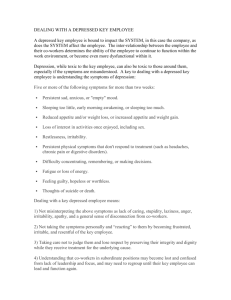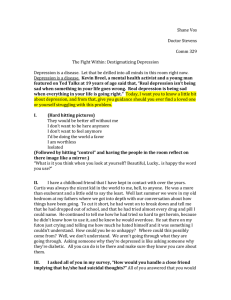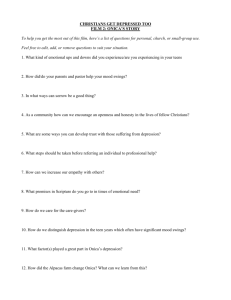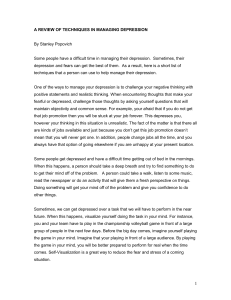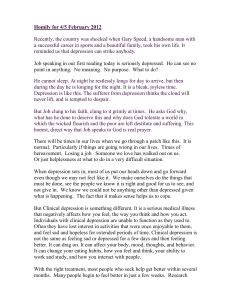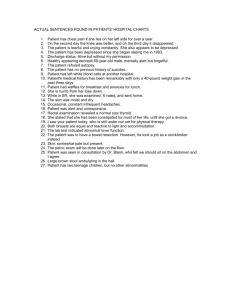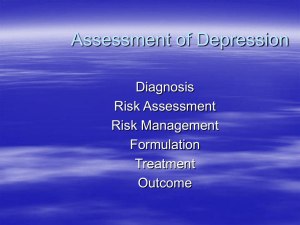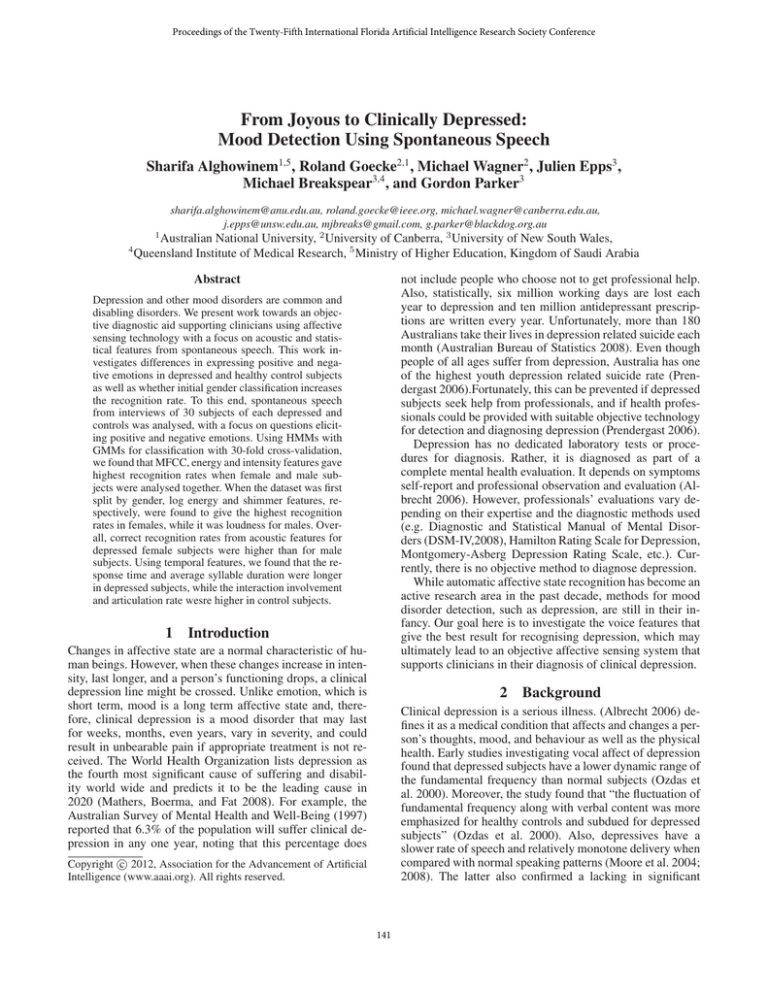
Proceedings of the Twenty-Fifth International Florida Artificial Intelligence Research Society Conference
From Joyous to Clinically Depressed:
Mood Detection Using Spontaneous Speech
Sharifa Alghowinem1,5 , Roland Goecke2,1 , Michael Wagner2 , Julien Epps3 ,
Michael Breakspear3,4 , and Gordon Parker3
sharifa.alghowinem@anu.edu.au, roland.goecke@ieee.org, michael.wagner@canberra.edu.au,
j.epps@unsw.edu.au, mjbreaks@gmail.com, g.parker@blackdog.org.au
Australian National University, 2 University of Canberra, 3 University of New South Wales,
Queensland Institute of Medical Research, 5 Ministry of Higher Education, Kingdom of Saudi Arabia
1
4
Abstract
not include people who choose not to get professional help.
Also, statistically, six million working days are lost each
year to depression and ten million antidepressant prescriptions are written every year. Unfortunately, more than 180
Australians take their lives in depression related suicide each
month (Australian Bureau of Statistics 2008). Even though
people of all ages suffer from depression, Australia has one
of the highest youth depression related suicide rate (Prendergast 2006).Fortunately, this can be prevented if depressed
subjects seek help from professionals, and if health professionals could be provided with suitable objective technology
for detection and diagnosing depression (Prendergast 2006).
Depression has no dedicated laboratory tests or procedures for diagnosis. Rather, it is diagnosed as part of a
complete mental health evaluation. It depends on symptoms
self-report and professional observation and evaluation (Albrecht 2006). However, professionals’ evaluations vary depending on their expertise and the diagnostic methods used
(e.g. Diagnostic and Statistical Manual of Mental Disorders (DSM-IV,2008), Hamilton Rating Scale for Depression,
Montgomery-Asberg Depression Rating Scale, etc.). Currently, there is no objective method to diagnose depression.
While automatic affective state recognition has become an
active research area in the past decade, methods for mood
disorder detection, such as depression, are still in their infancy. Our goal here is to investigate the voice features that
give the best result for recognising depression, which may
ultimately lead to an objective affective sensing system that
supports clinicians in their diagnosis of clinical depression.
Depression and other mood disorders are common and
disabling disorders. We present work towards an objective diagnostic aid supporting clinicians using affective
sensing technology with a focus on acoustic and statistical features from spontaneous speech. This work investigates differences in expressing positive and negative emotions in depressed and healthy control subjects
as well as whether initial gender classification increases
the recognition rate. To this end, spontaneous speech
from interviews of 30 subjects of each depressed and
controls was analysed, with a focus on questions eliciting positive and negative emotions. Using HMMs with
GMMs for classification with 30-fold cross-validation,
we found that MFCC, energy and intensity features gave
highest recognition rates when female and male subjects were analysed together. When the dataset was first
split by gender, log energy and shimmer features, respectively, were found to give the highest recognition
rates in females, while it was loudness for males. Overall, correct recognition rates from acoustic features for
depressed female subjects were higher than for male
subjects. Using temporal features, we found that the response time and average syllable duration were longer
in depressed subjects, while the interaction involvement
and articulation rate wesre higher in control subjects.
1
Introduction
Changes in affective state are a normal characteristic of human beings. However, when these changes increase in intensity, last longer, and a person’s functioning drops, a clinical
depression line might be crossed. Unlike emotion, which is
short term, mood is a long term affective state and, therefore, clinical depression is a mood disorder that may last
for weeks, months, even years, vary in severity, and could
result in unbearable pain if appropriate treatment is not received. The World Health Organization lists depression as
the fourth most significant cause of suffering and disability world wide and predicts it to be the leading cause in
2020 (Mathers, Boerma, and Fat 2008). For example, the
Australian Survey of Mental Health and Well-Being (1997)
reported that 6.3% of the population will suffer clinical depression in any one year, noting that this percentage does
2
Background
Clinical depression is a serious illness. (Albrecht 2006) defines it as a medical condition that affects and changes a person’s thoughts, mood, and behaviour as well as the physical
health. Early studies investigating vocal affect of depression
found that depressed subjects have a lower dynamic range of
the fundamental frequency than normal subjects (Ozdas et
al. 2000). Moreover, the study found that “the fluctuation of
fundamental frequency along with verbal content was more
emphasized for healthy controls and subdued for depressed
subjects” (Ozdas et al. 2000). Also, depressives have a
slower rate of speech and relatively monotone delivery when
compared with normal speaking patterns (Moore et al. 2004;
2008). The latter also confirmed a lacking in significant
c 2012, Association for the Advancement of Artificial
Copyright Intelligence (www.aaai.org). All rights reserved.
141
Table 1: Duration (mins) of Depressed and Control speech
expression as previously found by (Darby, Simmons, and
Berger 1984) when they described the triad in depressive
speech of reduced stress, monopitch, and monoloudness.
Research on the vocal indicators in depressed subjects
found an increase in pause time and a decrease in speech
rate in depressives (Ellgring and Scherer 1996). (Zlochower
and Cohn 1996) measured the vocal timing in clinically depressed mothers in response to their 4-months-old infants
and concluded that depressed mothers had longer and more
variable duration of silence. They found that the response
delay increases with the severity level of depression. Therefore, we will analyse not only the voice feature but also
the response time and duration of speech. Applying these
previous findings of the characteristics of depressed speech
with the acoustic features for spontaneous depressed speech
is an under researched area. We investigate whether certain
features can give better depression recognition. Recently,
(Cummins et al. 2011) investigated depressed speech from
read material and found that Mel-frequency cepstral coefficients (MFCC) and spectral centroid amplitudes were good
discriminating features for speaker dependent and independent depression recognition.
In this paper, we look for a general characteristic for depressed spontaneous speech by examining, which acoustic
features or feature groups can give better recognition, and
whether these features give better results taking the subject’s
gender into account. We also examine duration and speech
rate features to discriminate depressed speech.
Questions
All 8 questions
“Good News”
“Bad News”
3.2
3.1
Male Only
Depressed
Control
77.48
62.59
7.51
5.01
12
11.01
Female Only
Depressed
Control
112.15
45.09
10.16
5.39
14.65
5.19
Participants
To date, data from over 40 depressed subjects with over 40
age-matched controls (age range 21-75yr, both females and
males) has been collected. Before participating, each subject
was invited to complete a ‘pre-assessment booklet’ (general
information, e.g. health history), then interviewed by trained
researchers following the DSM-IV diagnostic rules. Participants who met the criteria for depression were selected.
In this paper, a subset of 30 depressed subjects and 30
controls were analysed, with equal gender balance. Only native English speaking participants were selected in this research, to reduce the variability that might occur from different accents. For depressed subjects, the level of depression
was a selection criterion, with a mean of 19 points of the
diagnoses using DSM-IV (range 14-26 points, where 11-15
points refer to a “Moderate” level, 16-20 points to a “Severe”
level, and ≥ 21 points to a “Very Severe” level).
We acknowledge that the amount of data used here is relatively small, but this is a common problem (Ozdas et al.
2000; Moore et al. 2008). As we continue to collect more
data, future studies will be able to report on a larger dataset.
3.3
3
All gender
Depressed
Control
189.63
107.68
17.66
10.40
26.64
16.20
Data Preparation
The interview part was manually labelled to separate questions and speakers. Within the questions, the speakers were
manually labelled with a focus on the lag between the interview asking the question and the participant answering it to
measure the response time for depressed and non-depressed
subjects. In addition, the duration of the overlap between
speakers was labelled to measure the involvement style. The
duration of subjects’ laughs was labelled for further investigation, as well as the duration and the number of the interviewer’s interactions to elicit speech from the participants.
Out of a total 513min of interviews (313min for depressed
and 200min for controls), the duration of “pure” subject
speech (without silence) for depressed and control subjects
for all 8 questions, the “Good News” question and the “Bad
News” question used in this paper is shown in Table 1.
Methodology
Data Collection
For the experimental validation, we use data collected in
an ongoing study at the Black Dog Institute, a clinical research facility in Sydney, Australia, offering specialist expertise in depression and bipolar disorder. Subjects include
healthy controls as well as patients who have been diagnosed with pure depression, i.e. those who have no other
mental disorders or medical conditions. Control subjects are
carefully selected to have no history of mental illness and
age and gender match the depressed subjects. The experimental paradigm contains several parts, including an interview with the subjects (McIntyre et al. 2009). The interview is conducted by asking specific questions (in 8 question
groups), where the subjects are asked to describe events that
had aroused significant emotions. In this paper, the interview
part with all 8 question groups is used for analysing spontaneous depressive speech. We also compare the expression
of positive and negative emotions by analysing two related
questions from the interview: “Can you recall some recent
good news you had and how did that make you feel?” and
“Can you recall news of bad or negative nature and how did
you feel about it?” For simplicity, these two questions will
be referred to as “Good News” and “Bad News”, resp. We
assume that those questions elicit the emotions, even though
the answers were not validated for certain emotions.
3.4
Feature Extraction
Speech features can be acquired from both uttered words
(linguistic) and acoustic cues (para-linguistic). However, linguistic features including word choices, sentence structure
etc. are beyond the scope of this study. We would also like
to generalise the findings to other languages in the future.
Acoustic Features. In general, the more relevant features
to recognise affect are considered to be duration, MFCC,
energy and pitch variation (Batliner and Huber 2007). This
view has been supported by a study that found the most relevant acoustic features to emotions are duration and energy,
while all other features are of medium relevance (Schuller
142
Table 2: Weighted Average Recall and F1 measures (in %)
for acoustic feature classification from all 8 questions
et al. 2007). A study on communication difficulties found
that among duration, energy, and F0 features, duration was
the feature that contributed most to classification (Batliner
et al. 2003). Using all acoustic features together gives better
results than single features (Schuller et al. 2007).
Several software tools are available for extracting and
extracting sound features. In this work, we used the publicly available open-source software “openSMILE” (Eyben, Wöllmer, and Schuller 2010) to extract several low
level voice features and functional features from the subject
speech labelled intervals (Table 2). The frame size is set to
25ms at a shift of 10ms and using a Hamming window.
Feature Group
Feature
Pitch
F0
F0 row
F0 direction
Voice prob.
MFCC
MFCC
MFCC,∆,∆∆
Energy
root mean
log energy
Intensity
Loudness
Intensity
Formants
3 Formants
voice quality
Jitter
Shimmer
voice quality
HNR
Average
Statistical Measures. Duration features were extracted
from the manually labelled intervals for further statistical
analysis. Regarding speaking rate, a Praat (Boersma and
Weenink 2009) script by (De Jong and Wempe 2009) was
used to calculate the speech and articulation rates as well
as the pause rate. When measuring the speech rate, pauses
are included in the duration time of the utterance, while the
articulation rate excludes pauses (Goldman-Eisler 1968).
3.5
All gender
WARF 1D F 1C avg.F1
4.1
Female Only
WARF 1D F 1C avg.F1
64
66
64
56
78
74
78
64
0
50
0
45
39
62
39
55
47
58
55
41
63
64
71
50
10
50
0
29
36
57
36
40
67
70
71
65
77
79
83
73
36
48
0
49
57
63
42
61
64
66
70
76
55
44
60
63
58
47
66
63
46
10
36
56
67
72
74
80
53
53
67
64
70
69
80
74
36
61
58
67
80
70
74
73
40
67
57
70
77
71
86
79
33
57
60
68
70
62
80
76
36
0
58
38
64
52
74
68
40
0
57
34
77
71
86
83
33
0
60
42
64
78
0
39
55
71
0
36
71
83
0
42
63
66
66
54
64
77
79
76
62
75
6
13
44
41
29
41
46
60
51
52
52
50
67
34
55
60
62
76
40
65
38
26
47
27
29
49
44
61
33
47
71
77
77
63
71
83
86
84
72
81
0
33
57
45
33
42
60
71
59
57
4
Classification and Evaluation
Male Only
WARF 1D F 1C avg.F1
Results
Acoustic Features
We evaluated the depression recognition rate with and without initial (manual) gender separation to establish the influence of gender. Table 2 shows the WAR and F1 measures
for each acoustic feature analysed here w.r.t. gender.
In general, recognising depression in female subjects was
better in most features with a WAR mean of 71%, while
males had a WAR mean of only 55%, with a mixed gender result of a WAR mean of 64%. This result confirms previous conclusions of gender differences (Nolen-Hoeksema
1987) that depressed women may be more likely to be detected than depressed men. This might be related to the fact
that women are more likely to amplify their moods, while
men are more likely to engage in distracting behaviours
that dampen their mood when depressed (Nolen-Hoeksema
1987). The energy and intensity feature groups were the
best features for mixed gender depression classification, in
line with (Batliner and Huber 2007). The energy features in
particular were the best features for male depression classification (cf. (Darby, Simmons, and Berger 1984)). While
most features were good for female depression classification, shimmer alone and log energy were the best ones, and
Harmonic-to-Noise Ratio (HNR) was the worst.
Moreover, the recognition results for MFCC features were
slightly better with the inclusion of the first (∆) and second
(∆∆) order derivatives than using MFCC features by themselves, but not in a statistically significant wat. This result is
consistent with (Cummins et al. 2011), which analysed data
from the read sentences of the Black Dog Institute data set,
while our analysis here is on the spontaneous speech data,
as well as in line with (Low et al. 2009), where there was
only a 3% increase in the accuracy of depression classification. Using raw F0, i.e. without thresholding (i.e. forcing to
0) in unvoiced segments, gives better classification results
than using thresholded F0. The reason lies in the fact that
the HMM gives better results for continuous data streams
(Yu and Young 2011). As an example for the results of our
The spontaneous speech was classified in a binary speakerindependent scenario (i.e. depressed/non-depressed). An initial classification of gender (from voice) can increase the
accuracy of the overall affect classification, while misclassifying gender may give the opposite results (Vogt and
Andre 2006). Therefore, manual gender classification was
used in ours study to test the overall accuracy. Besides investigating the effect of prior gender classification, a particular
comparison between expressing positive and negative emotions between depressed and control subjects was examined.
Hidden Markov Models (HMM) are a suitable and widely
used way of capturing the temporal information in the acoustic features extracted from speech. Following the approach
of many para-linguistic speech classification studies, the
Hidden Markov Model Toolkit (HTK) was used to implement a HMM using one state to train a Gaussian Mixture Model (GMM) with 16 mixtures and 10 iterations. The
choice of the number of mixtures was fixed to ensure consistency in the comparison, knowing that some features benefit
more from more detailed modelling. To mitigate the effect
of the limited amount of data, a 30-fold leave-one-out crossvalidation was used. That is, 29 different subjects were used
in each turn to create a model, which the remaining subject
in each turn then was tested against to ensure a valid evaluation and prevent contaminating the results (Schuller et al.
2011). This was done for both cohorts, resp.
In order to measure the performance of the system, several statistical methods could be calculated, such as accuracy, precision, recall, F1 measure (the harmonic mean of
recall and precision), Kappa, and confusion matrix (Schuller
et al. 2011). Another way is by graphing the results either
using Detecting Error Trade-Off (DET) or Receiver Operating Characteristic (ROC) curves. In this paper, the weighted
average recall (WAR) and F1 measures were computed and
weighted using the duration in Table 1.
143
Table 3: Weighted Average Recall and F1 measures (in %)
for acoustic feature classification from “Good News”
Feature Group
Feature
Pitch
F0
F0 row
F0 direction
Voice prob.
MFCC
MFCC
MFCC,∆,∆∆
Energy
root mean
log energy
Intensity
Loudness
Intensity
Formants
3 Formants
voice quality
Jitter
Shimmer
voice quality
HNR
Average
All gender
WARF 1D F 1C avg.F1
Male Only
WARF 1D F 1C avg.F1
Female Only
WARF 1D F 1C avg.F1
61
72
63
57
76
79
77
62
0
55
0
49
38
67
39
56
44
61
44
40
30
67
30
35
53
52
53
44
42
60
42
40
53
73
65
56
67
81
79
61
16
54
0
48
42
67
40
55
61
71
67
80
52
51
59
65
55
67
66
77
32
39
49
58
64
69
71
74
54
62
62
68
69
71
79
76
39
63
59
69
65
68
75
73
43
60
59
67
75
73
84
78
42
66
63
72
71
65
80
78
46
13
63
45
65
65
75
78
43
24
59
51
75
68
84
80
42
13
63
46
63
77
0
39
53
67
19
43
65
79
0
40
63
68
65
52
65
77
80
74
60
75
0
24
46
40
32
39
52
60
50
53
59
56
60
43
56
73
72
69
36
62
11
0
44
48
38
42
36
57
42
50
65
70
66
53
66
79
81
74
60
75
0
24
52
44
34
40
52
63
52
55
Table 4: Weighted Average Recall and F1 measures (in %)
for acoustic feature classification from “Bad News”
Figure 1: DET curves for the pitch features group classification results using all 8 questions for both genders combined
Feature Group
Feature
Pitch
F0
F0 row
F0 direction
Voice prob.
MFCC
MFCC
MFCC,∆,∆∆
Energy
root mean
log energy
Intensity
Loudness
Intensity
Formants
3 Formants
voice quality
Jitter
Shimmer
voice quality
HNR
Average
system, Figure 1 shows DET curves for each Pitch feature
group using all questions for both genders combined.
While acknowledging the potential impact of the huge reduction of training data from using all 8 questions to using only one question, we investigated the differences in expressing positive and negative emotions between depressed
and control subjects. This was done by evaluating the “Good
News” and “Bad News” questions from the spontaneous
speech data. While the subjects’ answers were not validated
for a certain emotion, we assume that the questions elicited
positive and negative emotions, resp.
For the “Good News” question (positive emotion), recognising depression was almost as accurate as when using all
8 questions, both with and without prior gender separation
(Table 3). Getting good recognition rates from such a small
dataset indicates the clearly noticeable differences in expressing positive emotions in depressives and controls.
On the other hand, analysing the “Bad News” question
(negative emotion), gives worse recognition rates than using all 8 questions or the positive question (Table 4). This
indicates that both groups express negative emotions in the
same or a similar manner. Linking this finding with the previous one, we conclude that positive emotions are expressed
less in depressed subjects at all times, that negative emotions
dominate in depressives (Ekman 1994; Ekman and Fridlund
1987) and, hence, negative emotional speech has less discriminatory power than positive emotional speech.
4.2
All gender
WARF 1D F 1C avg.F1
Male Only
WARF 1D F 1C avg.F1
Female Only
WARF 1D F 1C avg.F1
37
60
39
40
6
68
6
38
53
45
54
42
30
57
30
40
48
47
51
37
59
51
61
44
27
42
34
29
43
47
48
36
43
66
64
33
58
78
78
42
11
29
0
21
34
53
39
32
52
62
59
71
40
42
50
57
44
45
56
62
26
0
41
31
63
39
74
44
32
31
53
38
66
63
78
71
27
49
53
60
55
64
68
68
22
58
45
63
72
63
83
76
20
16
52
46
64
63
76
77
26
6
51
42
58
52
70
69
31
0
51
34
67
74
80
85
18
0
49
42
54
67
22
44
52
69
0
34
50
61
29
45
43
55
43
48
53
27
63
42
47
53
54
40
45
49
40
40
52
43
48
46
48
45
45
20
47
12
20
60
21
53
63
58
10
19
28
38
39
35
20
40
74
36
64
22
55
85
24
77
20
64
0
45
23
24
20
42
34
50
22
42
to first response, total length of response, length of subject
laughing, length of both subject and interviewer laughing,
length of overlapping speech (Table 5). All statistical significance tests were one-tailed T-tests for two samples assuming
unequal variances and p=0.05. Table 5 shows the probability value and the direction of effect (DIR.) to indicate which
group (depressed -D- or control -C-) has a stronger effect.
• First response time – The duration of the silence after asking a question until an acknowledgement indicated by any
sounds or words that are not the actual answer for the
question (e.g. “ahhh”,“hmm”, “well”, etc.) was longer in
depressed subjects, especially in depressed males, in line
with (Zlochower and Cohn 1996; Ellgring and Scherer
1996). While we measured the first response time manually, it could be measured automatically using speaker
diarization techniques.
• Total response time – Differences in the lag between asking the question and the actual answer were not statistically significant between the two groups.
Statistical Analysis of Temportal Features
As mentioned earlier, manually labelled speaker turns were
used to extract duration for statistical analyses of temporal
features, namely length of subject speech, length of interviewer (RA) speech, number of RA interactions (turns), time
144
Table 6: T-test for speech rate features for all questions
Table 5: T-test for speech duration for all 8 Questions
Feature
Subject Speech
RA Speech
# RA Interaction
First Response
Total Response
Subject Laughing
Both Laughing
Overlap Speech
All gender
P value
DIR.
0.057
D>C
0.44
D>C
0.002
D>C
0.013
D>C
0.49
D>C
0.007768
C>D
0.000006
C>D
0.000001
C>D
Male Only
P value
DIR.
0.32
D>C
0.38
D>C
0.16
D>C
0.030
D>C
0.26
D>C
0.11
C>D
0.005
C>D
0.003
C>D
Female Only
P value
DIR.
0.05025
D>C
0.48
C>D
0.00152
D>C
0.11
D>C
0.33
C>D
0.01316
C>D
0.00010
C>D
0.00003
C>D
Feature
Speech Rate
Articulation Rate
Average Syllable Dur.
Pause Rate
Average Pause Dur.
Male Only
P value
DIR.
0.42
D>C
0.18
D>C
0.36
C>D
0.9
D>C
0.037
C>D
Female Only
P value
DIR.
0.1
C>D
0.003
C>D
0.012
D>C
0.16
C>D
0.42
C>D
For the purpose of comparing positive and negative emotions, speech rate features were extracted for the specific related questions. For positive emotions (“Good News” question), the results from the T-test were similar to the results
using all questions. There were only two differences between using all questions and “Good News” question:
• Duration of the RA speech – No statistically significant
difference between two groups, but the Number of RA interactions was higher for depressives to encourage them
to speak more, which may be the reason for having longer
speech duration for depressed subjects (Subject Speech).
• In the “Good News” question, the pause rate was lower
in the depressed group than when using all questions, especially in males, which indicates longer pauses.
• Laughs duration – Measured to indicate a positive reaction. Depressives laughed less, especially females.
• Duration of overlapping speech – The involvement by depressed subjects was less than by the controls.
• The Average Pause Duration (#pauses / total silence duration) was higher in depressives with and without prior
gender separation than in controls in the “Good News”
question, indicating longer pauses.
The T-test for the “Good News” question alone showed
comparable results to when all 8 questions were used. In
contrast, the ”Bad News” T-test showed that there were
almost no statistically significant differences between depressed and controls, which supports the finding in Sec. 4.1.
There were two differences between using all 8 questions
and the “Good News” question:
For the negative emotion comparison, there were no significant differences between depressed and controls, which
supports the previously mentioned findings that both groups
express negative emotions in a similar manner.
5
• Longer total response time in depressed subjects in the
“Good News” question.
Conclusions
Our aim is to work towards an objective affective sensing
system that supports clinicians in their diagnosis of clinical
depression. To this end, we investigated which features are
better for recognising depression from spontaneous speech
and whether initial gender separation influences the recognition rate. This included both acoustic and temporal features.
In general, we conclude that recognising depression from female subjects was better in most acoustic features than for
male subjects. Log energy and shimmer features (individually) were the best for recognising depression in females,
while loudness was the best feature for depression recognition in males. For mixed genders, MFCC, energy and intensity features gave better recognition rates.
We also investigated the difference in expressing positive and negative emotions in depressed and control subjects.
We found that expressing positive emotions in spontaneous
speech resulted in higher correct recognition for depressed
and control subjects, while there were no statistically significant differences between the cohorts in spontaneous speech
related to negative emotions. Furthermore, we found that
using data from the positive emotion question resulted in
recognition rates almost equal to those when using all questions. However, when using only the negative emotion question, the recognition rate dropped; implying that depressed
and control subjects express negative emotions in a similar
manner and that the differences between the two cohorts best
express themselves in the positive emotion data.
Analysing duration, we found that the response time was
longer in depressed, that the interaction involvement was
higher in controls, and that controls laughed more often than
• A significant difference in laugh duration between depressed and control subjects when using all questions, but
not when only using the “Good News” question.
4.3
All gender
P value
DIR.
0.21
C>D
0.056
C>D
0.036
D>C
0.07
C>D
0.17
C>D
Speech Rate Features
Speech rate, articulation rate and pause rate were extracted
using Praat (De Jong and Wempe 2009). T-tests were applied
to the results to indicate statistically significant differences
between the two groups. All T-tests were one-tailed for two
samples assuming unequal variances and p=0.05. Table 6
shows the probability value and the direction of effect (DIR.)
to indicate which group (depressed -D- or control -C-) has a
stronger effect.
• Average syllable duration (total duration-pauses duration
/ # syllables) was longer for the depressed group, especially females, which indicates that depressives speak
slower than controls (in line with (Moore et al. 2004)).
• Articulation rate (#syllables / total duration-pauses duration) was lower in depressives, especially females (in line
with (Pope et al. 1970)).
• Speech rate (#syllables / total duration) was not significantly different.
• Pause rate (#pauses / total duration) was not significantly
different.
• The only feature with significant differences for depressed
males was the average pause duration (#pauses / total silence duration), which was higher than in male controls.
145
Mathers, C.; Boerma, J.; and Fat, D. 2008. The Global Burden of Disease: 2004 Update. Geneva, Switzerland: WHO.
McIntyre, G., and Goecke, R. 2007. Towards Affective
Sensing. In HCII2007, volume 3 of LNCS 4552, 411–420.
McIntyre, G.; Goecke, R.; Hyett, M.; Green, M.; and Breakspear, M. 2009. An Approach for Automatically Measuring
Facial Activity in Depressed Subjects. In ACII2009, 223–
230.
Moore, E.; Clements, M.; Peifer, J.; and Weisser, L. 2004.
Comparing objective feature statistics of speech for classifying clinical depression. Proc. 26th Ann. Conf. Eng. Med.
Biol. 1:17–20.
Moore, E.; Clements, M.; Peifer, J. W.; and Weisser, L.
2008. Critical analysis of the impact of glottal features in the
classification of clinical depression in speech. IEEE Transactions on Bio-medical Engineering 55(1):96–107.
Nolen-Hoeksema, S. 1987. Sex differences in unipolar depression: Evidence and theory. Psychol (101):259–282.
Ozdas, A.; Shiavi, R.; Silverman, S.; Silverman, M.; and
Wilkes, D. 2000. Analysis of fundamental frequency for
near term suicidal risk assessment. IEEE Conf. Systems,
Man, Cybernetics 1853–1858.
Pope, B.; Blass, T.; Siegman, A. W.; and Raher, J. 1970.
Anxiety and depression in speech. Journal of Consulting
and Clinical Psychology 35(1):128–133.
Prendergast, M. 2006. Understanding Depression. VIC
Australia: Penguin Group.
Saragih, J., and Goecke, R. 2006. Iterative Error Bound
Minimisation for AAM Alignment. In ICPR2006, volume 2,
1192–1195.
Schuller, B.; Batliner, A.; Seppi, D.; Steidl, S.; Vogt, T.;
Wagner, J.; Devillers, L.; Vidrascu, L.; Amir, N.; and
Kessous, L. 2007. The relevance of feature type for the
automatic classification of emotional user states: Low level
descriptors and functionals. 2253–2256.
Schuller, B.; Batliner, A.; Steidl, S.; and Seppi, D. 2011.
Recognising realistic emotions and affect in speech: State of
the art and lessons learnt from the first challenge. Speech
Communication 53(February):1062–1087.
Vogt, T., and Andre, E. 2006. Improving Automatic Emotion Recognition from Speech via Gender Differentiation. In
LREC2006.
Yu, K., and Young, S. 2011. Continuous F0 Modeling for
HMM Based Statistical Parametric Speech Synthesis. IEEE
Trans. Audio, Speech, and Lang. Proc. 19(5):1071–1079.
Zlochower, A. J., and Cohn, J. F. 1996. Vocal timing in faceto-face interaction of clinically depressed and nondepressed
mothers and their 4-month-old infants. Infant Behavior and
Development 19(3):371 – 374.
the depressed. With the speech rate analysis, we found that
the average syllable duration was longer in depressed, especially females, and that the articulation rate was lower in
depressed females, which confirms previous results that depressed subjects speak more slowly than non-depressed.
6
Limitations and Further Work
This paper is a first in a series of investigations of depression cues from the Black Dog Institute dataset. Fusing face
(Saragih and Goecke 2006), body, eye features with this current research will be a next step towards multi-modal system (McIntyre and Goecke 2007). A known limitation is the
fairly small number of (depressed and control) subjects. As
data collection is ongoing, we anticipate to report on a larger
dataset in the future.
References
Albrecht, A. T. 2006. 100 Questions & Answers About Depression. Jones & Bartlett Learning, 1 edition.
Australian Bureau of Statistics, A. 2008. Causes of death
2006. Number 3303.0.
Batliner, A., and Huber, R. 2007. Speaker classification i.
Berlin, Heidelberg: Springer-Verlag. chapter Speaker Characteristics and Emotion Classification, 138–151.
Batliner, A.; Fischer, K.; Huber, R.; Spilker, J.; and Nth, E.
2003. How to find trouble in communication. Speech Communication 40(1-2):117 – 143.
Boersma, P., and Weenink, D. 2009. Praat: doing phonetics
by computer.
Cummins, N.; Epps, J.; Breakspear, M.; and Goecke, R.
2011. An Investigation of Depressed Speech Detection: Features and Normalization. In Proc. Interspeech 2011.
Darby, J. K.; Simmons, N.; and Berger, P. A. 1984. Speech
and voice parameters of depression: a pilot study. Journal of
Communication Disorders 17(2):75–85.
De Jong, N. H., and Wempe, T. 2009. Praat script to detect syllable nuclei and measure speech rate automatically.
Behavior Research Methods 41(2):385–390.
Ekman, P., and Fridlund, A. J. 1987. Assesment Of Facial
Behvior In Affective Disorders. In Depression and Expressive Behavior. x. Hillsdale, N.J: Lawrence Erlbaum. 37–56.
Ekman, P. 1994. Moods Emotions And Traits. In P. Ekman
& R. Davidson (Eds.) The Nature of Emotion: Fundamental
Questions. New York: Oxford University Press. 15–19.
Ellgring, H., and Scherer, K. R. 1996. Vocal indicators of
mood change in depression. Journal of Nonverbal Behavior
20(2):83–110.
Eyben, F.; Wöllmer, M.; and Schuller, B. 2010. Opensmile:
the munich versatile and fast open-source audio feature extractor. In Proc. ACM Multimedia (MM’10), 1459–1462.
Goldman-Eisler, F. 1968. Psycholinguistics: Experiments in
spontaneous speech. Academic Press.
Low, L.-S. A.; Maddage, N. C.; Lech, M.; and Allen, N.
2009. Mel frequency cepstral feature and Gaussian Mixtures for modeling clinical depression in adolescents. In
2009 IEEE Int. Conf. Cognitive Informatics, 346–350.
146

